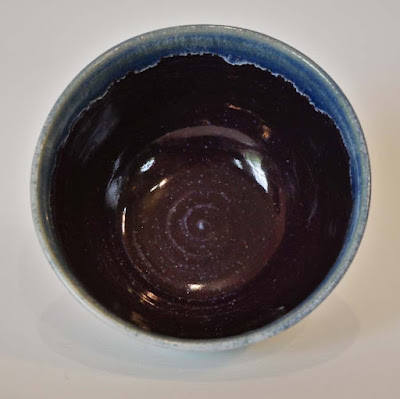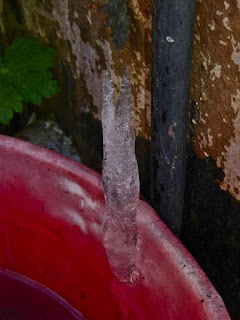Glazes over Glazes!
Last December I glaze fired some jugs, bowls and cups and took photos with the intention of updating the blog, but didn't quite get round to it at the time. Anyway, we can travel time on the blog, so let us wind the clock back to when I unpacked some pots from the kiln. I rather liked some of the combinations of glazes that I tried, so here are a few of them!
This small bowl was glazed with a modified chrome-tin glaze on the inside, and a magnesium matte glaze on the outside. The blue "breaking wave" effect is where the two glazes overlap just inside the rim of the bowl.
The magnesium matte is "Buttermilk" (with a dash of about 1 percent copper carbonate added) from John Britt's Cone 10 Glaze book, and the chrome-tin red is my own (the recipe is on my high fire glaze page of this blog). I added about 1 percent of cobalt oxide to the red glaze to turn it dark purple. The interesting thing is that the cobalt dominates things where the magnesium matte flows over it, and you get a nice variegated blue. The outside of the bowl is a silky matte white with just a hint of green from the copper that I added to it. In all, with this combination, you get three colours from two glazes!
Magnesium matte glazes usually get their magnesium from Talc which is magnesium silicate, or from dolomite which is a mineral that is a natural combination of calcium and magnesium. Occasionally magnesium carbonate is used, but this oddly light-weight material isn't always the easiest to play with when making up a glaze, and dolomite or talc are usually better behaved. Magnesium mattes have a lovely silky smooth feel to them - think of talcum powder - and matte the glaze by forming thousands of tiny crystals.
Other matte glazes include calcium, barium and alumina mattes. All have their own distinctive look and feel.
Another way of slightly matting and adding an exciting sprinkle of tiny crystals to a glaze is to add rutile. Rutile is a mineral that is composed mostly of titanium dioxide, along with some iron impurities.
This bowl is glazed with Chance's Opal, which is a glaze that has a lot of rutile in it for texture and copper for colour. You can find a recipe for Chance's Opal on glazy.org which is a website I highly recommend for potters who are interesting in making their own glazes.
Chance's Opal has 7 percent rutile in it which can give a great result, however I do find that it can get a bit ugly in the bottom of bowls with far too many crystals if allowed to pool too thickly, so I developed a variation that I used in the bowl in the photo where I first poured a modified version of the glaze with only 2 percent rutile in the bowl, then dipped the rim and sides of the bowl in the 7 percent rutile version of the glaze leaving the centre untouched. I like the result.
I had a feeling this glaze would do nice things over a good dark iron bearing glaze, such as the black tenmoko that I often use (recipe on my high fire glaze page).
Over a dark glaze it will yield an exciting range of blues and greens, often with a pale foamy looking edge. The glaze also tends to move or run when put over the tenmoko glaze, and this can give spectacular results, but care has to be taken to protect kiln shelves from any run off glaze. I usually place a thin piece of insulating firebrick under pots that have a potentially fluid glaze.
All the pots in the photos were fired in oxidation in my electric kiln to cone 9.








Comments